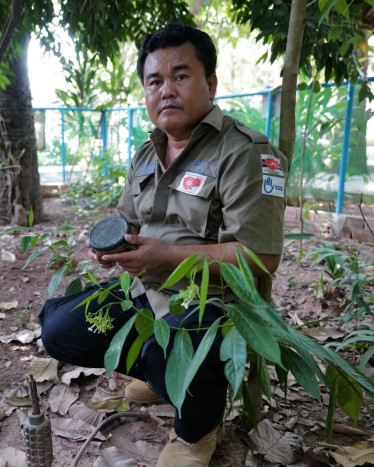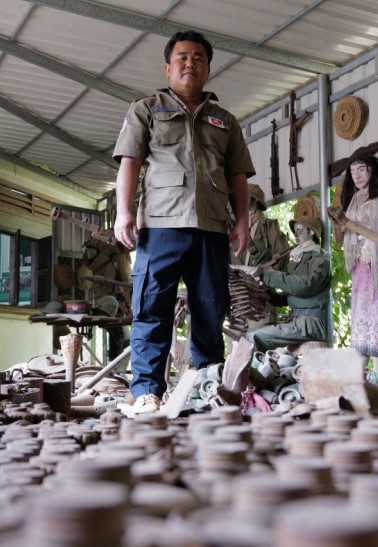share

Aki Ra photographed in the Landmine Museum he founded before starting his demining operations | © T. Mayer / HI
13 years after the trial of “Comrade Duch”, the Khmer Rouge torturer convicted of crimes against humanity, a former child soldier turned deminer tells his story.
Aki Ra laid his first mines when he was just 5 or 6 years old. He survived 20 years of war and now dedicates his life to mine clearance. The founder of CSHD [Cambodian Self-Help Demining], a national demining organisation supported by HI, explains that he has helped to clear more than 9.5 million m² of land in Cambodia.
Aki Ra says he is 50 years old but does not know his real age. His identity card states that he was born on 1 January 1975. That same year, the Vietnam War came to an end, but in neighbouring countries such as Cambodia, the violence did not stop. On the contrary, the country entered one of the darkest periods in its history.
 On 17 April 1975, Pol Pot, the leader of the Khmer Rouge (the Communist Party of Kampuchea) seized power and imposed his totalitarian regime in Phnom Penh. During four years of violent dictatorship, the soldiers in red bandanas and black uniforms imprisoned, tortured and massacred nearly two million innocent people.
On 17 April 1975, Pol Pot, the leader of the Khmer Rouge (the Communist Party of Kampuchea) seized power and imposed his totalitarian regime in Phnom Penh. During four years of violent dictatorship, the soldiers in red bandanas and black uniforms imprisoned, tortured and massacred nearly two million innocent people.
They had two weapons of choice: landmines and children. In fact, one of the regime's proudest achievements was conscripting children into the army, after tearing them from their parents' arms and then executing them.
Aki Ra is one of these survivors.
“I was one of the youngest soldiers. There were boys and girls. Some child soldiers liked to play with pistols, I liked mines”.
Mines are “powerful toys”, he says, with as much coldness as naivety. Like the other child soldiers, Aki Ra's first job was to cook, hunt in the jungle or bring food to the soldiers on the front line.
Then he was ordered to kill. Taken prisoner by the Vietnamese troops who had come to eradicate Pol Pot’s regime, Aki Ra found himself on the other side of the battlefield for several months. He experienced war at its harshest: the tracking, the fatigue, the death and the blood. He continued to lay hundreds of mines until the Khmer Rouge was completely disbanded.
“I've seen so many people mourning the loss of their loved ones, losing everything that was dearest to them. One day, my boss asked us to lay explosive devices in the ground. It was in a field about 100 metres long. I told my comrades that we all had to move away from each other before we started to mark out the territory. While the others laid their mines, I dug a pit into which I put at least 50 devices, and I buried them there. I made sure that everything was secure. That day, I said to myself ‘never again in my life’, I decided that from that moment on, and for the rest of my life, I was going to get rid of them”.
After serving in Cambodia's national army, which rose from the ashes of the dictatorship, Aki Ra joined the United Nations programme to clear Cambodia’s mines. The former child soldier, now a deminer, has survived 20 years of war. His country is now one of the most mine-contaminated areas in the world.
He decided to open a museum: the Cambodia Landmine Museum. A vast collection of defused explosive devices and archives just a few steps from the small house where he now lives with his three children.
“I wanted to tell young people about the history of their country and the wars it has been through, tell tourists about the danger of mines and then... I wanted to get the support of the whole world to help us clear the mines”.
 He then founded his own humanitarian organisation, CSHD. It was in this context that his path crossed that of HI in the Siem Reap region, in the north of Cambodia. HI provides operational and administrative support to the organisation, with the aim of enabling CSHD to become an autonomous national mine-action NGO.
He then founded his own humanitarian organisation, CSHD. It was in this context that his path crossed that of HI in the Siem Reap region, in the north of Cambodia. HI provides operational and administrative support to the organisation, with the aim of enabling CSHD to become an autonomous national mine-action NGO.
Leonard Kaminski is HI's mine-action specialist in Cambodia:
“Initially, Aki Ra and his teams cleared contaminated land manually using simple metal detectors. We have trained them in the latest, more modern and more effective technologies”.
More than 9.5 million square meters of land have been cleared since CSHD was set up in 2008.
“The biggest challenge we face is locating landmines efficiently. These explosive devices have been used as personal weapons by soldiers such as Aki Ra, and on a larger strategic scale by the army. Strategic minefields are fairly easy to find, but the task is much more difficult when it comes to mines deployed haphazardly by the soldiers themselves”.
Cambodia is still committed to becoming a “mine-free” country by 2025. This is the third time the authorities have extended the deadline. The stakes are still very high. Every day, HI teams measure the positive impact of demining operations in the field. As soon as a footbridge is cleared of mines, a whole village comes back to life.
“In the village of Toul Kros (Siem Reap province), for example, every time we clear a half-hectare block, the villagers reclaim the land and start farming again. That's why we always start by clearing minefields. Seeing a minefield become a paddy field again, or in some places a cashew-nut orchard, while we're still working close to the village, is more than encouraging!”
Aki Ra is also targeting farmers in this recently cleared rural area:
“Please don't be afraid to farm your land. We're working every day to clear it of mines, so you don't have to worry anymore!”








HI is an independent and impartial aid organisation working in situations of poverty and exclusion, conflict and disaster. We work alongside people with disabilities and vulnerable populations, taking action and bearing witness in order to respond to their essential needs, improve their living conditions and promote respect for their dignity and fundamental rights.
HI is an independent and impartial aid organisation working in situations of poverty and exclusion, conflict and disaster. We work alongside people with disabilities and vulnerable populations, taking action and bearing witness in order to respond to their essential needs, improve their living conditions and promote respect for their dignity and fundamental rights.